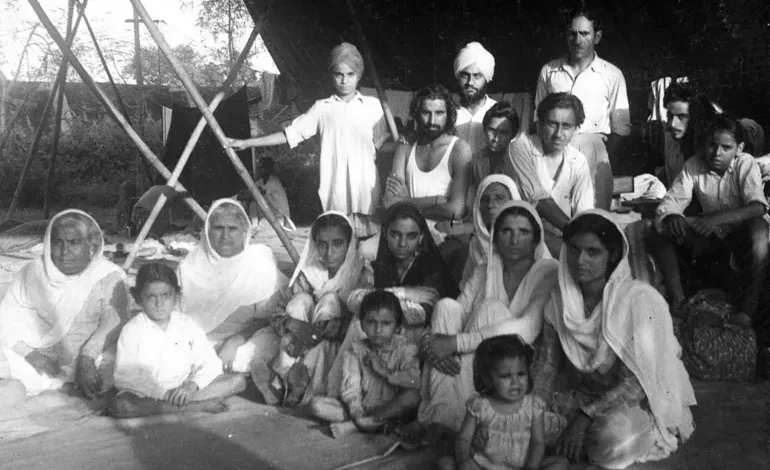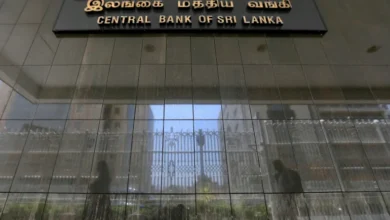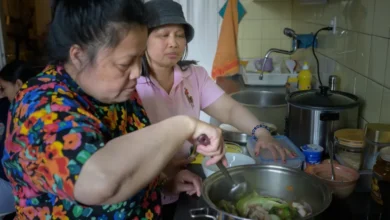Sisters divided: How partition ruptured a family in a vanishing community

She walked out of her bedroom a few minutes after I arrived, the pallu of her sari draped, as always, across her right shoulder, Gujarati in style. Shireen* smiled at me as she slowly made her way to the couch, her short grey hair resting on her neck. For the next few hours, we sat in the lounge, amid remnants that each told their own story. An over 60-year-old grandfather clock from England, her father’s rocking chair from old Lahore, a table carved by woodworkers in Bombay (now known as Mumbai) several decades ago. Shireen rested her hands, etched with fine lines, in her lap and I noticed her fingers. I could visualise a young version of her joyfully playing the piano, a career abruptly halted by the partition of British India in 1947.
“We really belong to both places,” she began. “We belong to the undivided subcontinent. When I was required here, I was here. When I was required there, I was there and I would keep coming and going.”
“Although it wasn’t ever easy to come and go,” Amy*, added from beside her.
“No, it has never been,” Shireen agreed softly.
It was November 2012 and I was sitting with Shireen and Amy, two sisters, in their home nestled in an affluent neighbourhood in the city of Lahore. I was researching for my first book, The Footprints of Partition. Ever since I had first heard about Shireen and Amy’s story, I had wanted to learn more about their experiences in 1947 and the subsequent decades. Shireen, then in her early 80s, and Amy, 12 years younger, were from the Zoroastrian community, commonly also referred to as the Parsi community (a title specific to South Asian Zoroastrians).
I had first met them a year prior, as part of an oral history project for The Citizens Archive of Pakistan (CAP), a non-profit dedicated to cultural and historical preservation. With a dwindling population in Lahore, Shireen and Amy were two people my colleagues and I interviewed to document the history and traditions of Zoroastrians. Since then, we had kept in touch. They were warm and hospitable, introducing my colleagues and me to other members of the community, inviting us to partake in community festivities and opening their home to us. It was during one of these interactions that I had learned that while Shireen was Indian, her sister, Amy, was Pakistani.
Born decades after the partition, amid rising animosity between India and Pakistan, it was difficult for me to imagine two sisters divided by hostile notions of nationality. But such was the reality for families that had been separated in 1947 when the British carved the subcontinent into two, drawing lines haphazardly, slicing villages and towns in half.
Partition had led to one of the largest migrations the world had ever witnessed, with approximately 12 million people crossing the newly established borders of India and Pakistan: Muslims moving west and Hindus and Sikhs east. In official history though, little attention was paid to what happened to the communities caught in between. What were the lived implications for people like Shireen and Amy? What did it mean for one to become Indian and the other Pakistani? What did it mean to have a sisterhood partitioned?
‘Like sugar in the milk’
As is described in the book, A White Trail: A Journey into the Heart of Pakistan’s Religious Communities, by Haroon Khalid: “It is believed that upon the spread of Islam to Persia in the seventh century CE, a small band of Zoroastrians – a dominant religion in the region until then – set out from Persia and found their way to Sanjan, a city in present-day Gujrat, India. Upon arriving, the leader of the community sent a message to the ruler and asked him for permission to live there. When the request was declined, the leader asked for a bowl of milk and some sugar. He mixed a handful of sugar into the milk and sent it back, with a message that the Parsi community would be like sugar in the milk: invisible yet present. He promised that his community would blend in, adopting local customs and culture, while never preaching or converting others to their religion.“The king was impressed and the community was allowed to settle. They were eventually given the title of “Parsi” – the people who came from Persia. Upholding the promise made by their leader, the community took on the Gujarati language and culture, including traditional Gujarati clothes, food and songs.”
Shireen’s sari, tied in Gujarati style, with the pallu on the right as opposed to the left, as it is worn in other parts of India, was reminiscent of this promise made far away from Lahore, a long time ago.
Back in that room, she told me that at the time of partition, her family was already long settled in Lahore. “Our father would have never shifted anywhere as this was where he had lived, his forefathers had lived; this was his home. He also believed that the politics of the state had nothing to do with us; that whether a Muslim or Hindu government was in place, we Parsis would remain unaffected.”
This belief was shared by others from the community too. As violence broke out between Muslims, Hindus and Sikhs, Parsis remained neutral, and convinced that they would continue to live in Pakistan regardless of who came to power in the region, blending in again as they had once done before.
But the events of 1947 and thereafter would soon leave an impact on the community. In the post-partition subcontinent, as religious and national identities blurred – with India being perceived over time as a Hindu nation and Pakistan as a Muslim nation, religious minorities have faced social, political and economic repercussions.Over time, the Parsi community has shrunk significantly. In 2013, it was reported that there were only 35 Parsis left in Lahore. Across Pakistan, there are fewer than 1,000. While some married outside of the community, converting to other religions, others migrated to countries in North America or Europe. In Shireen and Amy’s case, the repercussions of partition were felt even more personally and rather soon after 1947.
‘We just prayed and prayed – we knew it was a matter of fate’
Born in 1930 in Bombay – where her mother was originally from – and raised in Lahore, Shireen spent her early years familiar with both cities. She completed her education in Lahore, studying with Hindu, Muslim and Sikh classmates at the Cathedral School. But come summer, she and Amy would board the Frontier Mail with their mother to visit her maternal home in Bombay. “Our mother was never able to let go of her emotional ties with the city…whenever we would go there, she was so much more at ease, so relaxed over there,” Shireen told me.
After partition, however, Shireen believed that her mother felt “a wedge had been built between her early life in Bombay and her life here in Lahore. Of course, she eventually reconciled with living here but emotionally she was always there, in Bombay, even until she died in 2004.”
Shireen, though, did not feel the same rupture as her mother, not initially. Lahore, after all, was where her school, friends and immediate family were. She thought she’d still have a chance to visit Bombay, even if it now strangely lay in another country, across the freshly carved border. As a 17-year-old student passionate about the piano, she was more preoccupied with gearing up for her music examinations, scheduled to take place in Lahore right around the time of partition. But with Punjab being one of the two provinces cut in half in 1947, the city of Lahore was marked with violence and unrest and the examiner from the Trinity College London, who was meant to examine Shireen, could not come. She told me she cried her eyes out until her parents decided that they would send her to Bombay where the conditions were better and examinations were still under way.
“Those were some of the most frightening hours of my life,” she told me. Shireen recalled how the train shutters were pulled down and passengers sat huddled together in fear of being attacked as communal violence unleashed around them. “None of us knew if we would get there alive. We just sat there and prayed and prayed. We knew it was just a matter of fate, whether our train would be attacked or the one after…it was all about luck.”
Though Shireen made it across and aced her examination, she now faced the hurdle of getting back to Lahore, where she needed to appear for one of her university examinations that had earlier been cancelled due to the political turmoil of partition. She had to make three trips to the airport before she was able to get a flight but, by this time it was December 1947, and only shuttle flights were running to Lahore. With planes not being able to accommodate the overflow of traffic, seats had been removed from the aircrafts to make space for more passengers – people left sitting on top of their baggage. When she finally made it home, she told me she found her mother weeping. She had not known if her daughter would make it home alive.
Shireen had returned to Lahore from the US in 1955 and was running her own music show on Radio Pakistan when the news came in that her family’s property in Bombay might be at risk of being taken over by the Indian government; few years later, in 1968, India would pass a law giving the government powers to seize property belonging to citizens of a state considered an “enemy state”. In practice, this would mean anyone holding Pakistani citizenship.
Shireen’s father had assets in Bombay and, fearing that they could be seized, he instructed her, as the eldest daughter, to travel across the border to take care of the property. By this time Shireen was 27 while Amy was 15.
As Shireen reached this part of the story, the pain she had experienced became visible. “I felt absolutely awful,” she told me. “My life as a pianist was [suddenly over]. And yet I was the only person [who could go]; Amy was too young, and my parents couldn’t leave, so there was only me left. We grew up being obedient to our parents so, whether I liked it or not, I was sent off.” Just as her mother had been separated from her Bombay, Shireen was forced to give up Lahore, the wounds of partition cutting across generations.
It was 1957 by the time she left and it took her three years to acquire citizenship which she needed to ensure her father’s property would not be seized. This meant relinquishing her Pakistani citizenship and she was left for that time without any official nationality at all. She was not the only one. Countless other people like her were roaming government offices, pleading their cases. “My situation was so common that when you went to the police and told them you were from Lahore, they wouldn’t bat an eyelid.”
The struggles with paperwork did not end with her citizenship, however. Only a few years after Shireen moved to India, the 1965 Indo-Pak war broke out. It was after this war that visas became even harder to obtain, and the border, once more porous, allowing people to cross over far more easily, hardened.Amy, who had sat beside Shireen in a shalwar kameez throughout this story, told me she was in fact in Bombay visiting her grandparents when the war started. She recalled the curfews, the blackout. “The windows would have to be covered with black paper [to avoid being targeted] and my cousins and I would spend evenings with a recipe book, trying out new recipes because there was nothing else to do.”
Despite being in the same country as her sister, Amy explained that she couldn’t meet her. Shireen was by now settled elsewhere in India and Amy only had a permit for Bombay. Shireen, meanwhile, was unable to get leave from her job. “It was a pity that being in the same country as my sister, we were still so far away from each other.”
As tensions escalated and planes were cancelled, Amy said she felt absolutely stuck. While she eventually made it home, she told me: “I remember constantly waiting to hear of the next flight home. I wanted to get back as soon as I could, to go back to my parents. I couldn’t even speak to them during this time. We’d have to send messages via England or another third country.”
By 1971, Pakistan and India were once again at war, this time over the birth of Bangladesh. For divided families like Shireen and Amy’s, each time tensions escalated at the border, it became more and more difficult to maintain contact let alone visit one another. They told me it had been a few years since they had met, although they couldn’t remember the exact dates.
“We had wanted to see each other so badly that finally my sister and I decided to meet in Kabul instead.” It was the 1970s by this time. I looked up from my notes and noticed that it was at this moment, for the very first time in our conversation, that Shireen had begun to cry, reminded of the ordeal of those years, the difficulties of being separated from her family. But as she recollected the moments they were finally able to spend together, her expression changed. “We spent quite some weeks there and it was lovely. We caught up on so many things we had missed out on over the years. She told me about her friends, about our mother and father, that we had moved [homes]. It was the first time in all those years that I felt complete, felt connected with my family,” she told me, her eyes tender.
In the years following, sometimes Shireen got a visa to travel to Lahore, and sometimes her mother and sister were able to come to India, but these visits, she tells me, were always difficult. The paperwork, the police reporting (it is often a requirement that visitors have to report their entry and exit to each city at a police office), the bureaucracy and red tape – all weighed heavily on their brief interactions.
Hoping to hold on to both worlds
The approvals, or lack thereof, from security officials often shape the lives of divided families.
Malik Siddiqui, an elderly man I interviewed at his home in Lahore, shared a similar story. Siddiqui was born in Uttar Pradesh (in present-day India) and, at a young age, became an ardent supporter of the Muslim League, passionate about fighting for a separate homeland for Muslims. In 1952, at the age of 18, he set off alone for Pakistan, leaving behind his family, many of whom supported the Congress – one of the major political parties in undivided and post-partition India, which stood in opposition to the Muslim League – and decided to continue living in India.Malik explained how he had imagined he would be able to keep both worlds, crossing borders easily to visit his parents and friends back in India while creating a home in the newly formed nation that held promise for Muslims like him. And for the first few years, he was able to acquire the required permits to visit, but as tensions heightened between both countries, and borders became more divisive, getting visas and travelling across was no longer simple. He told me he missed both his mother’s and father’s funeral. “You have to fight a constant struggle every day, to visit, to be one with them. I don’t regret my decision but I had never realised how much I would have to give up for Pakistan…”
Tina Vachani, a Hindu woman I interviewed while she was in Delhi, had moved from Karachi, Pakistan to Delhi, India as a young 14-year-old, leaving behind her parents.
When I interviewed her for The Footprints of Partition, she told me that what was initially intended to be a short trip to visit her grandparents in 1971 had turned into a permanent move. India and Pakistan went to war while she was travelling and communication links between both countries broke down. Like many others with families on both sides, Tina found herself caught in the middle. She was travelling on a Pakistani passport, with an Indian visa. Unable to get an extension during the war, her maternal family helped her apply for Indian citizenship. In the process, she had to renounce her Pakistani nationality. While this was meant to solve the bureaucratic troubles, in the years after red tape and paperwork would continue to create fractures in her life.
She told me of her desperate attempts to get a visa to be able to visit her family. It was after several years of trying, in the late 1970s, that her father tried to pull a few strings to at least be able to meet his daughter at the Wagah Border, a land border between Lahore, Pakistan and Amritsar, India).
Tina was ecstatic. “Imagine not being able to go home for seven or eight years…so much had changed [since I last met my parents] …I had so much to tell them, so much to ask…about home, about our neighbourhoods, my friends…” She told me her parents were waiting anxiously at the Pakistani gate; they had travelled from Karachi to Lahore to see her and she had travelled from Delhi to Amritsar to meet them, even if for a brief moment. But the security official on her side refused to let her move forward. “He kept saying I needed special permission from some ministry and so on and so forth. I hadn’t met my father for so many years, but he just wouldn’t allow me to go to the gate.”
She paused at this point in the story, taking a deep breath before continuing. “Unfortunately, I didn’t get to see [my family]. A couple of months later, my father had a heart attack and died.”










